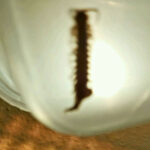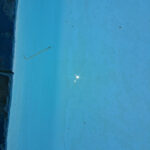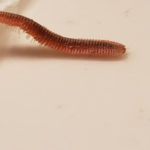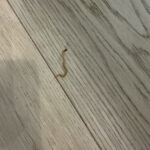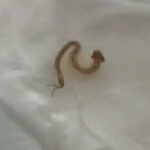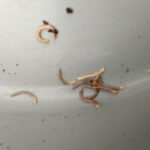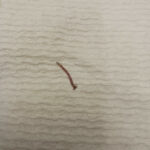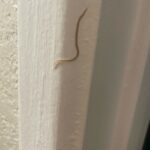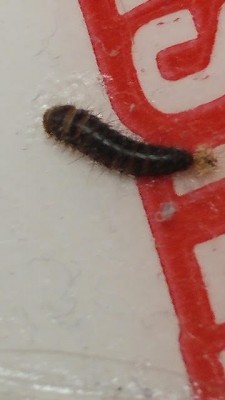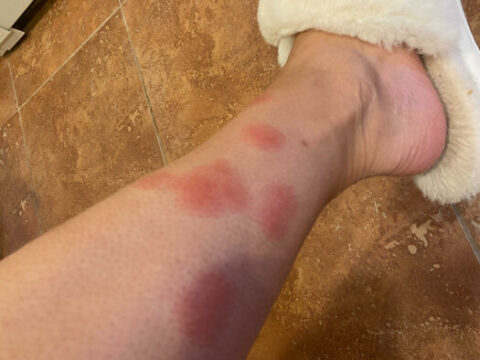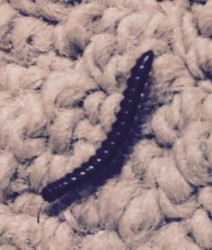
A reader recently sent in a query about finding live, big worms in her small, ground-floor apartment in Florida, as well as very small and thin worms that follow them inside. Our reader presumes that the worms find their way into her home under the entrance doors to her apartment. The smaller worms are apparently about an inch in length, “a drop thicker than a needle”, and tannish in color.
In addition to this, its features are uniform from head to tail. This makes them difficult to spot, as they blend in with our reader’s laminate floors. The tiny worms stay straight when moving at their slow pace, but wriggle when disturbed. Furthermore, our reader has already had an exterminator work at her house, and yet continues to find these worms in her house afterward. She worries about these worms being potentially unsafe to her small dog, although she did take her dog to the vet, who said the dog was fine.
Although we appreciate that our reader gave extensive details as to the location, behavior, and characteristics of the worms she found, it is very difficult to identify the worms without a photograph. Based on the color, uniformity of its body, and its ability to walk completely straight, our best educated guess would be that this creature is a millipede. In fact, our reader’s question was posted as a comment on a previous post about millipedes, so perhaps our reader already had an inkling about what this creature might be. The image below, taken from our own library of photographs, displays what a millipede might look like up close. Of course, this one is black in color, whereas the one our reader described was tan in color.
Millipedes are athropods; they have bodies which are split into multiple segments, each with its own set of legs underneath, all of which can total 160 legs. Although the amount of legs is substantial, it does not quite live up to the meaning of their name ‘thousand feet’. Regardless, it is their multitude of legs which allows them to seemingly glide across surfaces without contracting or moving their bodies much. And just as our reader has described, millipedes tend to curl up and wriggle when provoked. This is a defense mechanism which protects their sensitive underside using its segmented exoskeleton. Luckily, if these worms are millipedes, our reader needs not fear for her dog’s safety. Millipedes are composting worms, meaning they feed on decaying organic matter, and are thus not parasitic to animals or humans. For the same reason, millipedes are actually beneficial to the environment!
Yet, it is very strange that our reader noticed that these worms seemed to follow after groups of bigger worms. Unfortunately, neither descriptions nor photos were provided of this larger worm, so there is really no way we can identify it. If the worm did turn out to be a parasite, it is possible that these smaller worms were feeding on the bigger worms, and then exited their bodies to find new hosts. However, this is very unlikely. Not only do the smaller worms’ size and physical features not match that of any known, common parasite, but parasitic worms that feed off other insects tend to feed on other fully-formed insects. Is is uncommon that a worm would feed off another worm.
In regards to dealing with an infestation of millipedes, there is not much our reader can do in terms of permanently ridding her property of them, but there are methods of preventing future infestations. First of all, whatever millipedes are already inside our reader’s home should be removed in a careful and humane fashion, so as not to kill the critters. Secondly, as millipedes thrive in dark and damp environments, our reader should make sure that there is no moisture build-up in her home that the millipedes could be attracted to. Additionally, if there are any spots outside our reader’s property that match the description of a millipede’s ideal habitat that can potentially be removed, we recommend doing so as well. This could include piles of rocks or leaves, or watering cans that have been left out. This may reduce the number of millipedes that come onto one’s property, as they become forced to look elsewhere for shelter. Lastly, we recommend that our reader installs some sort of material on the underside of her entrance doors (perhaps rubber strips) that could prevent the millipedes from getting inside, and that she checks for any other cracks in her home that small creatures could potentially crawl through, and that she seals them.
To conclude, although we are not completely certain as to the identity of these small, tannish worms that our reader found in her apartment, we would presume them to be millipedes. Whilst millipedes are beneficial to the environment, and are not harmful to humans or pets, infestations of them can occur, so we encourage our reader to combat this as soon as possible.
All About Worms is always free, always reader-supported. Your tips via CashApp, Venmo, or Paypal are appreciated! Receipts will come from ISIPP Publishing.
You might also find these guys interesting!





